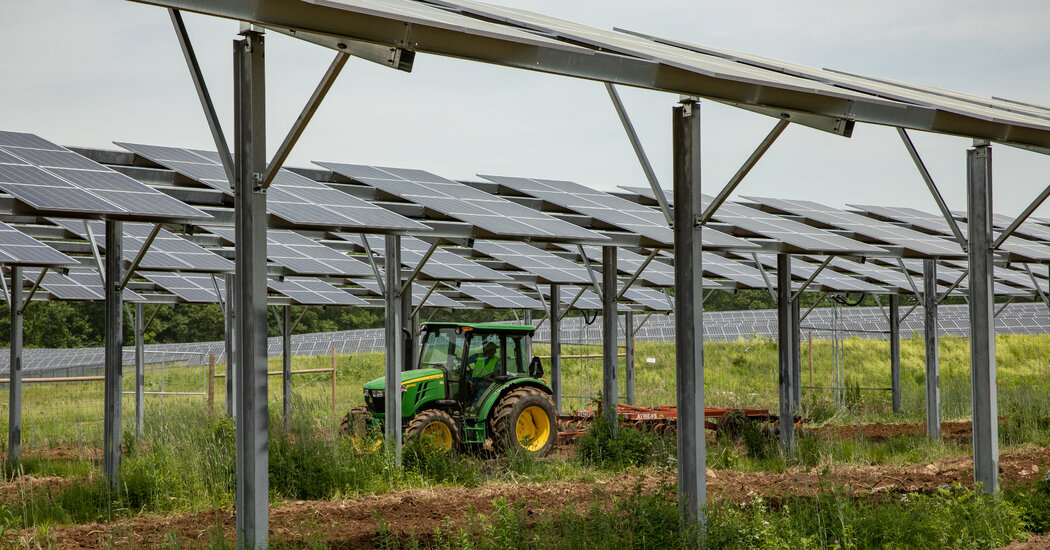
In its 150-year history, Paul Knowlton’s farm in Grafton, Mass., has produced vegetables, dairy products and, most recently, hay. The evolution of the farm’s use turned on changing markets and a variable climate. Recently, however, Mr. Knowlton added a new type of cash crop: solar power.
For Mr. Knowlton, a fifth-generation farmer and the current owner, it was an easy call. He had already installed solar panels to provide electricity for his home and barn. When a real estate agent came knocking to see if he was interested in leasing a small portion of his land for a solar array, “she planted the seed that I could do more,” Mr. Knowlton said.
Mr. Knowlton looked at several companies but was most impressed with BlueWave Solar, a developer in Boston that focuses primarily on solar installations and battery storage, which allows excess electricity to be fed to the power grid. Soon, two small parcels of largely unused land were home to low-to-the-ground panels that produce power. This year, Mr. Knowlton’s farm will go one step further: In a third parcel, solar panels will share space with crops so that both can thrive.
This approach is called agrivoltaics — a portmanteau of agriculture and voltaic cells, which transform solar power to electrical power. Also called dual-use solar, the technology involves adjusting the height of solar panels to as much as 14 feet, as well as adjusting the spacing between them, to accommodate equipment, workers, crops and grazing animals. The spacing and the angle of the panels allows light to reach the plants below, and has the added benefit of shielding those crops from extreme heat.
The electricity generated gets uploaded to the grid, typically through nearby substations. While some of the electricity may find its way to the host farm, the projects are devised to provide power for general use. And such solar installations provide an alternative source of revenue in the form of payments to landowners like Mr. Knowlton or a reduction in lease payments for tenant farmers.
BlueWave has focused primarily on designing the projects, then selling them to companies that build and oversee them. The Grafton project, on Mr. Knowlton’s farm, for example, is now owned by The AES Corporation, an energy company, who developed, built and is operating the project.
“Not only do agrivoltaics advance the clean energy imperative but they are critical to maintaining working farms,” said John DeVillars, one of BlueWave’s three co-founders and the chair of the board of directors.
Dual-use solar became of interest more than a decade ago because “big installations in the middle of nowhere aren’t going to solve all of our energy problems — transporting that energy can be very expensive,” said Greg Barron-Gafford, a biogeographer and an assistant professor at the University of Arizona. Farms in many parts of the country are in peri-urban areas, zones of transition from rural to urban land. Their proximity to high-use metropolitan areas makes open farmland particularly suitable for solar arrays, but in the past, without any coexisting agriculture, that sort of placement can set up a conflict over whether food or energy production should prevail.
In a study by AgriSolar Clearhouse, a new collaboration to connect farmers and other landowners with agrivoltaic technology, the installations were also shown to foster growth by shielding crops from increasing temperatures and aiding with water conservation. While the technology remains in its infancy in the United States compared with countries in Europe, where the technology has been used for over a decade, federal regulators as well as academics and developers are working to remedy that disparity.
Early results are promising, said Garrett Nilsen, the acting director of the Solar Energies Technologies Office of the U.S. Department of Energy. “There’s a project in Arizona where they’ve seen a threefold increase in crop yields when they are underneath this kind of system and up to a 50 percent reduction in irrigation requirements” because the panels provide shade, he said. Additionally, the plants under the panels release water into the air, which cools the modules, creating what Mr. Nelson described as a “symbiotic relationship between the plants and the panels.”
BlueWave’s first project to go live is a 10-acre farm in Rockport, Maine — now owned and operated by Navisun, a solar power producer. Wild blueberry cultivars have been planted below solar panels, which will produce 4.2 megawatts of power; the project is estimated to produce 5,468 megawatt-hours annually — equivalent to the amount of power needed for roughly 500 U.S. households.
Unlike Massachusetts, Maine does not offer significant incentives for the use of solar power, so there was a 10 to 15 percent premium on costs when compared with similar projects, which BlueWave absorbed, Mr. DeVillars said. (That practice is consistent with the company’s status as a so-called B-Corporation, which requires a commitment to social and environmental goals.)
Other players are clearly seeing the potential of agrivoltaics: In May 12, Axium Infrastructure, an investment management firm, announced its acquisition of BlueWave. Trevor Hardy will remain as chief executive and Eric Graber-Lopez will continue as president, while Mr. DeVillars will become chairman emeritus.
Mr. Hardy said that the sale would allow BlueWave to expand so that it will own and operate, not just develop, solar installations and battery storage. Ultimately, he said, the sale “puts us in a stronger place for dual use.”
“Farmers work on a long-term basis,” he continued. “It’s more compelling to drive up farm roads and sit with the owners at their kitchen tables and say that we develop, own and operate the installation.” And the technology’s potential goes well beyond blueberries; agricultural uses have included vineyards and shrimp farming.
BlueWave is not the only agrivoltaics developer. According to the Fraunhofer Institute for Solar Energy Systems ISE, based in Germany, five megawatts of power were produced through these systems in 2012; by 2021, 14 gigawatts of power were generated in dual-use systems — roughly equivalent to the electricity necessary for approximately two million U.S. households annually, according to a spokeswoman from the Department of Energy’s technologies office. And the technology is evolving rapidly; in the few years since the installation at Mr. Knowlton’s farm, adjustable panels that can move to maximize the capture of sunlight, for example, have been developed.
“It doesn’t always pay to be a pioneer and it’s very challenging at times,” said Mr. Hardy, who grew up in a South African farming family. Finding suitable sites — where there is sufficient sun and proximity to a substation or other electrical infrastructure — can be difficult. Opposition from neighbors, especially where panels are visible from other homes or even the road, is not uncommon.
Indeed, BlueWave was one of several defendants named in a suit over a proposed plan for agrivoltaics in Northfield, Mass. A state court recently ruled that the neighbor had standing to challenge the proposed development. One of the plaintiffs, Christopher Kalinowski, said that among his concerns were that his views would be obstructed and that “the area will lose farmland.” (Mr. Hardy declined to comment on the litigation.)
In addition, some chapters of the Audubon nonprofit environmental organization have been vocal about the technology’s potential effect on wildlife. Michelle Manion, the vice president of policy and advocacy for Mass Audubon, said that while her organization supported renewable energy, including solar within farming operations, “we want to maximize the placement of ground-mounted solar on some of our lands that are the least ecologically sensitive first.”
And there are general concerns that even with dual-use solar panels, arable land may be lost, though BlueWave says that the land can be reverted to pure agriculture uses once the solar leases — typically 20 to 30 years — expire.
But one of the most significant obstacles is cost. The skyrocketing cost of steel has a direct effect on agrivoltaics’ emphasis on raising the panels 10 to 14 feet. “For every foot you go up you need to go two feet into the foundation,” Mr. Hardy explained. “It’s a challenging industry when you think of what we need to do to reach climate goals. But we’re staying the course.”
Ultimately, though, everything depends on how the crops taste: If flavor or even appearance strays too far from that of traditional produce, the technology will be a hard sell. But in an early study, researchers at the Biosphere 2 Agrivoltaics Learning Lab at the University of Arizona found that tasters preferred the potatoes, basil and squash grown with agrivoltaics. Beans, however, may take some time: The small sample of tasters preferred the traditionally grown version.




